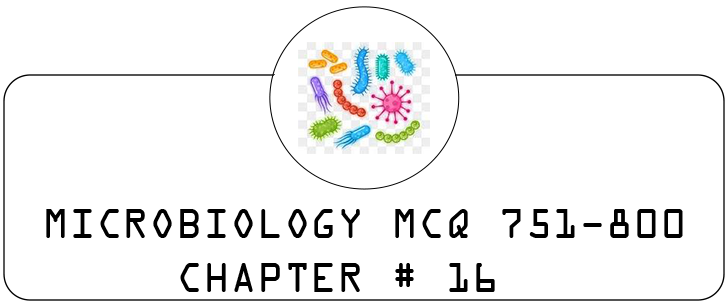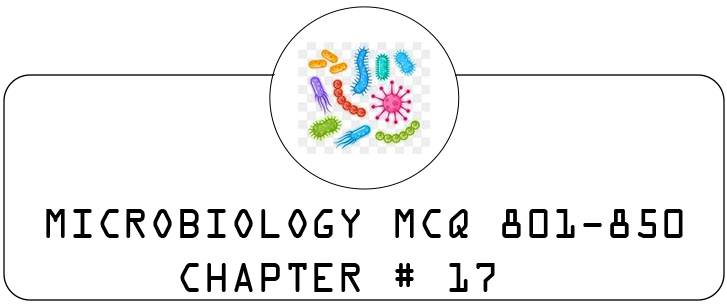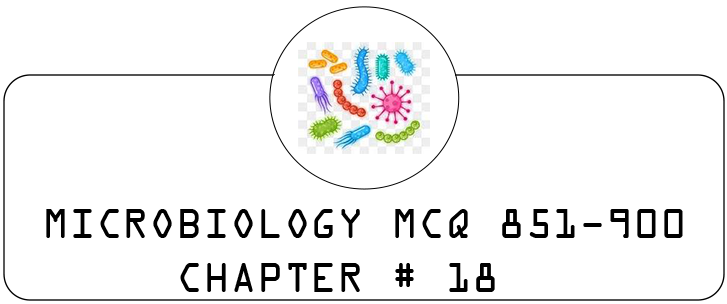701. The commonest infectious viral disease of man is:
A. Rabies
B. Chicken pox
C. Measles
D. Common cold ✅
A. Rabies
B. Chicken pox
C. Measles
D. Common cold ✅
702. Chemical contaminants in water can lead to teratogenicity, which can be defined as:
A. Ability to cause abortion in pregnant women
B. Ability to cause heritable changes in DNA
C. Ability to cause cancerous growth
D. Ability to cause abnormalities in developing fetus ✅
A. Ability to cause abortion in pregnant women
B. Ability to cause heritable changes in DNA
C. Ability to cause cancerous growth
D. Ability to cause abnormalities in developing fetus ✅
703. The therapy for genetic disorders which is aimed at mutant gene, to replace it with normal function gene by use of DNA/RNA tumor viruses is known as:
A. Active Immunotherapy
B. Genetic counseling
C. Gene therapy ✅
D. Interferon therapy
A. Active Immunotherapy
B. Genetic counseling
C. Gene therapy ✅
D. Interferon therapy
704. Intracytoplasmic inclusion bodies are seen for:
A. Echovirus
B. Rabies virus
C. Cytomegalovirus ✅
D. Influenza virus
A. Echovirus
B. Rabies virus
C. Cytomegalovirus ✅
D. Influenza virus
705. Transformation is defined as:
A. Transfer of DNA into bacterium ✅
B. Infection of bacterium with phage
C. Transfer of phage from one bacterium to another
D. None of the above
A. Transfer of DNA into bacterium ✅
B. Infection of bacterium with phage
C. Transfer of phage from one bacterium to another
D. None of the above
706. The bacterial cell wall is primarily composed of:
A. Cellulose
B. Chitin
C. Peptidoglycan ✅
D. Lipopolysaccharide
A. Cellulose
B. Chitin
C. Peptidoglycan ✅
D. Lipopolysaccharide
707. Which of the following is an example of an antiviral drug?
A. Penicillin
B. Acyclovir ✅
C. Tetracycline
D. Vancomycin
A. Penicillin
B. Acyclovir ✅
C. Tetracycline
D. Vancomycin
708. Which of the following bacteria are known to form spores?
A. E. coli
B. Bacillus ✅
C. Staphylococcus
D. Streptococcus
A. E. coli
B. Bacillus ✅
C. Staphylococcus
D. Streptococcus
709. The enzyme that synthesizes RNA from a DNA template is:
A. DNA polymerase
B. RNA polymerase ✅
C. Reverse transcriptase
D. Ligase
A. DNA polymerase
B. RNA polymerase ✅
C. Reverse transcriptase
D. Ligase
710. Which of the following is a characteristic of viruses?
A. They can reproduce independently
B. They have both DNA and RNA
C. They are obligate intracellular parasites ✅
D. They contain ribosomes
A. They can reproduce independently
B. They have both DNA and RNA
C. They are obligate intracellular parasites ✅
D. They contain ribosomes
711. What is the function of the capsule in bacteria?
A. Energy storage
B. Protection from phagocytosis ✅
C. DNA replication
D. Protein synthesis
A. Energy storage
B. Protection from phagocytosis ✅
C. DNA replication
D. Protein synthesis
712. The structure responsible for motility in bacteria is:
A. Pilus
B. Flagellum ✅
C. Fimbriae
D. Capsule
A. Pilus
B. Flagellum ✅
C. Fimbriae
D. Capsule
713. The most common type of infection caused by Staphylococcus aureus is:
A. Skin infections ✅
B. Urinary tract infections
C. Pneumonia
D. Meningitis
A. Skin infections ✅
B. Urinary tract infections
C. Pneumonia
D. Meningitis
714. The type of bacteria that require oxygen for growth are called:
A. Anaerobes
B. Aerobes ✅
C. Microaerophiles
D. Facultative anaerobes
A. Anaerobes
B. Aerobes ✅
C. Microaerophiles
D. Facultative anaerobes
715. The primary stain used in the Gram staining procedure is:
A. Safranin
B. Crystal violet ✅
C. Methylene blue
D. Carbol fuchsin
A. Safranin
B. Crystal violet ✅
C. Methylene blue
D. Carbol fuchsin
716. Which of the following is NOT a characteristic of fungi?
A. Eukaryotic
B. Heterotrophic
C. Prokaryotic ✅
D. Chitin in cell walls
A. Eukaryotic
B. Heterotrophic
C. Prokaryotic ✅
D. Chitin in cell walls
717. Which of the following is an example of a Gram-negative bacterium?
A. Staphylococcus
B. Streptococcus
C. Escherichia coli ✅
D. Clostridium
A. Staphylococcus
B. Streptococcus
C. Escherichia coli ✅
D. Clostridium
718. The most effective way to control viral infections is:
A. Antibiotics
B. Vaccination ✅
C. Disinfectants
D. Handwashing
A. Antibiotics
B. Vaccination ✅
C. Disinfectants
D. Handwashing
719. Which of the following diseases is caused by a virus?
A. Tuberculosis
B. Syphilis
C. Influenza ✅
D. Ringworm
A. Tuberculosis
B. Syphilis
C. Influenza ✅
D. Ringworm
720. Which of the following media is selective for Gram-negative bacteria?
A. Blood agar
B. MacConkey agar ✅
C. Chocolate agar
D. Nutrient agar
A. Blood agar
B. MacConkey agar ✅
C. Chocolate agar
D. Nutrient agar
721. Which of the following is a characteristic of endotoxins?
A. Heat-stable ✅
B. Excreted from living bacteria
C. Highly toxic
D. Protein in nature
A. Heat-stable ✅
B. Excreted from living bacteria
C. Highly toxic
D. Protein in nature
722. Which of the following is used to culture anaerobic bacteria?
A. Aerobic agar
B. Thioglycollate medium ✅
C. Blood agar
D. Nutrient broth
A. Aerobic agar
B. Thioglycollate medium ✅
C. Blood agar
D. Nutrient broth
723. The primary role of T lymphocytes in the immune response is to:
A. Produce antibodies
B. Kill infected cells ✅
C. Activate B cells
D. Produce cytokines
A. Produce antibodies
B. Kill infected cells ✅
C. Activate B cells
D. Produce cytokines
724. The primary way to sterilize laboratory glassware is by:
A. Autoclaving ✅
B. Soaking in alcohol
C. Boiling
D. Using disinfectants
A. Autoclaving ✅
B. Soaking in alcohol
C. Boiling
D. Using disinfectants
725. Which of the following is NOT an example of an opportunistic infection?
A. Pneumocystis pneumonia ✅
B. Candidiasis
C. Tuberculosis
D. Aspergillosis
A. Pneumocystis pneumonia ✅
B. Candidiasis
C. Tuberculosis
D. Aspergillosis
726. Which of the following stains is used to identify acid-fast bacteria?
A. Gram stain
B. Ziehl-Neelsen stain ✅
C. Giemsa stain
D. Crystal violet stain
A. Gram stain
B. Ziehl-Neelsen stain ✅
C. Giemsa stain
D. Crystal violet stain
727. The main component of the bacterial capsule is:
A. Lipids
B. Polysaccharides ✅
C. Proteins
D. Nucleic acids
A. Lipids
B. Polysaccharides ✅
C. Proteins
D. Nucleic acids
728. Which of the following is a characteristic of obligate anaerobes?
A. Require oxygen for growth
B. Killed by oxygen ✅
C. Can grow in the presence of oxygen
D. None of the above
A. Require oxygen for growth
B. Killed by oxygen ✅
C. Can grow in the presence of oxygen
D. None of the above
729. Which of the following methods is used for determining the concentration of viable cells?
A. Direct microscopic count
B. Plate count ✅
C. Turbidimetric methods
D. Spectrophotometry
A. Direct microscopic count
B. Plate count ✅
C. Turbidimetric methods
D. Spectrophotometry
730. The primary cause of dental caries is:
A. Streptococcus mutans ✅
B. Streptococcus pneumoniae
C. Staphylococcus aureus
D. Escherichia coli
A. Streptococcus mutans ✅
B. Streptococcus pneumoniae
C. Staphylococcus aureus
D. Escherichia coli
731. Which of the following is NOT a function of the microbiome?
A. Aid digestion
B. Produce vitamins
C. Cause disease ✅
D. Protect against pathogens
A. Aid digestion
B. Produce vitamins
C. Cause disease ✅
D. Protect against pathogens
732. The bacterium responsible for causing anthrax is:
A. Bacillus anthracis ✅
B. Escherichia coli
C. Staphylococcus aureus
D. Clostridium tetani
A. Bacillus anthracis ✅
B. Escherichia coli
C. Staphylococcus aureus
D. Clostridium tetani
733. The type of immunity that is acquired through natural exposure to a pathogen is:
A. Passive immunity
B. Active immunity ✅
C. Innate immunity
D. Herd immunity
A. Passive immunity
B. Active immunity ✅
C. Innate immunity
D. Herd immunity
734. Which of the following bacteria is responsible for tuberculosis?
A. Mycobacterium tuberculosis ✅
B. Streptococcus pneumoniae
C. Staphylococcus aureus
D. Escherichia coli
A. Mycobacterium tuberculosis ✅
B. Streptococcus pneumoniae
C. Staphylococcus aureus
D. Escherichia coli
735. The primary mode of transmission for the influenza virus is:
A. Fecal-oral
B. Respiratory droplets ✅
C. Blood
D. Direct contact
A. Fecal-oral
B. Respiratory droplets ✅
C. Blood
D. Direct contact
736. The primary site of bacterial infections in humans is:
A. Skin
B. Mucous membranes ✅
C. Blood
D. Bone
A. Skin
B. Mucous membranes ✅
C. Blood
D. Bone
737. The term vaccine was coined by:
A. Robert Koch
B. Louis Pasteur ✅
C. Needham
D. F. Redi
A. Robert Koch
B. Louis Pasteur ✅
C. Needham
D. F. Redi
738. The following bacteria have a single curve:
A. Borrelia
B. Vibrio ✅
C. Treponema
D. Pasteurella
A. Borrelia
B. Vibrio ✅
C. Treponema
D. Pasteurella
739. Albert’s stain (used for metachromatic granules staining) consists of all of the following except:
A. Toluidine blue
B. Carbol fuchsin
C. Malachite green
D. Acetic acid ✅
A. Toluidine blue
B. Carbol fuchsin
C. Malachite green
D. Acetic acid ✅
740. The cell wall of bacteria can be visualized by all of the following EXCEPT:
A. Azure II staining
B. Silver impregnation technique
C. Ultraviolet microscopy
D. Electron microscopy ✅
A. Azure II staining
B. Silver impregnation technique
C. Ultraviolet microscopy
D. Electron microscopy ✅
741. Gram positive bacteria are more susceptible to all of the following EXCEPT:
A. Sulfas and penicillin
B. Basic dyes
C. Anionic detergents
D. None of the above ✅
A. Sulfas and penicillin
B. Basic dyes
C. Anionic detergents
D. None of the above ✅
742. Which of the following is not absent in prokaryotes?
A. Mitochondria
B. Nucleolus
C. Muramic acid ✅
D. Sterols
A. Mitochondria
B. Nucleolus
C. Muramic acid ✅
D. Sterols
743. Genotypic variations are not:
A. Stable
B. Heritable
C. Influenced by environment ✅
D. Not influenced by environment
A. Stable
B. Heritable
C. Influenced by environment ✅
D. Not influenced by environment
744. The fungi which do not have a sexual stage are called:
A. Phycomycetes
B. Ascomycetes
C. Basidiomycetes
D. Fungi imperfecti ✅
A. Phycomycetes
B. Ascomycetes
C. Basidiomycetes
D. Fungi imperfecti ✅
745. The counter stain used in Zeihl Nielsen staining is:
A. Carbol fuchsin
B. Gentian violet
C. Gram’s iodine
D. Loeffler’s methylene blue ✅
A. Carbol fuchsin
B. Gentian violet
C. Gram’s iodine
D. Loeffler’s methylene blue ✅
746. Hepatitis A virus is:
A. Double stranded DNA
B. Single stranded DNA
C. Double stranded RNA
D. Single stranded RNA ✅
A. Double stranded DNA
B. Single stranded DNA
C. Double stranded RNA
D. Single stranded RNA ✅
747. Staphylococcus bacteria are:
A. Chemosynthetic autotrophs
B. Photosynthetic autotrophs
C. Chemosynthetic heterotrophs ✅
D. Photosynthetic heterotrophs
A. Chemosynthetic autotrophs
B. Photosynthetic autotrophs
C. Chemosynthetic heterotrophs ✅
D. Photosynthetic heterotrophs
748. Viruses come under the category:
A. Autotrophs
B. Hypotrophs
C. Heterotrophs ✅
D. L-forms
A. Autotrophs
B. Hypotrophs
C. Heterotrophs ✅
D. L-forms
749. Rhinovirus has:
A. Double stranded DNA
B. Single stranded DNA
C. Double stranded RNA
D. Single stranded RNA ✅
A. Double stranded DNA
B. Single stranded DNA
C. Double stranded RNA
D. Single stranded RNA ✅
750. _____ form of water is the most contaminated.
A. Underground water
B. Rainwater
C. Surface water ✅
D. Water stored in ice caps
A. Underground water
B. Rainwater
C. Surface water ✅
D. Water stored in ice caps





